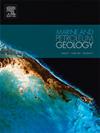Structural controls on hydrocarbon migration traced from direct hydrocarbon indicators at the southwestern margin of the Ulleung Basin, East Sea
IF 3.7
2区 地球科学
Q1 GEOSCIENCES, MULTIDISCIPLINARY
引用次数: 0
Abstract
This study presents a model for structural controls on hydrocarbon migration under the neotectonic regime at the southwestern margin of the Ulleung Basin in the East Sea, a marginal basin in the western Pacific. Based on comprehensive 3D multichannel seismic reflection and well data, we map the fault system and direct hydrocarbon indicators, including seismic chimneys and bright spots, at depths shallower than 1000 ms TWT (1144 m). We analyze the slip tendency of the 3D fault system based on current stress conditions newly estimated using focal mechanism data. Our results show that dextral strike-slip movements of NE–SW Group A faults, resulting in damage zones composed of subsidiary NW–SE to E–W Group B faults at tips and stepover zones, mainly accommodate the neotectonic deformation. The distribution of hydrocarbon indicators demonstrates spatial correlations with the fault system, indicating deformation-induced hydrocarbon migration and accumulation patterns. We emphasize that (1) along-fault zones and (2) releasing stepover zones of NE–SW Group A faults with a high tendency to slip have acted as main hydrocarbon migration pathways and accumulation zones. In addition, we suggest that trishear fault-related folding in a local transpression zone (the Gorae V anticline) can generate a forelimb with a high density of sub-seismic scale fracture corridors acting as active hydrocarbon pathways. Our findings increase the understanding of neotectonic deformation-induced hydrocarbon migration/accumulation patterns in the southwestern margin of the Ulleung Basin, contributing to assessment of hydrocarbon prospects, carbon dioxide capture and storage (CCS) opportunities, and submarine geohazards in western Pacific marginal basins with a similar tectonic setting.
求助全文
约1分钟内获得全文
求助全文
来源期刊

Marine and Petroleum Geology
地学-地球科学综合
CiteScore
8.80
自引率
14.30%
发文量
475
审稿时长
63 days
期刊介绍:
Marine and Petroleum Geology is the pre-eminent international forum for the exchange of multidisciplinary concepts, interpretations and techniques for all concerned with marine and petroleum geology in industry, government and academia. Rapid bimonthly publication allows early communications of papers or short communications to the geoscience community.
Marine and Petroleum Geology is essential reading for geologists, geophysicists and explorationists in industry, government and academia working in the following areas: marine geology; basin analysis and evaluation; organic geochemistry; reserve/resource estimation; seismic stratigraphy; thermal models of basic evolution; sedimentary geology; continental margins; geophysical interpretation; structural geology/tectonics; formation evaluation techniques; well logging.
 求助内容:
求助内容: 应助结果提醒方式:
应助结果提醒方式:


